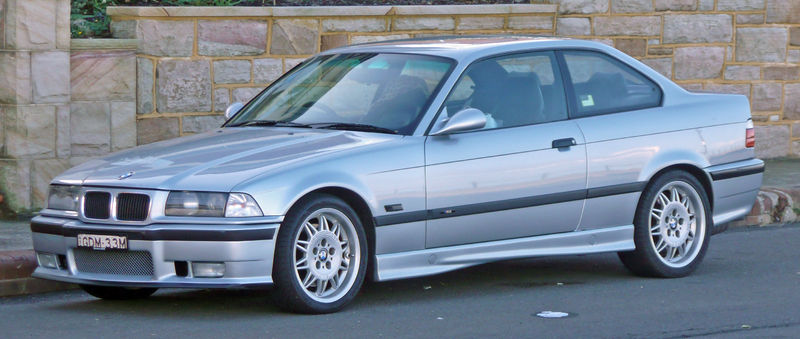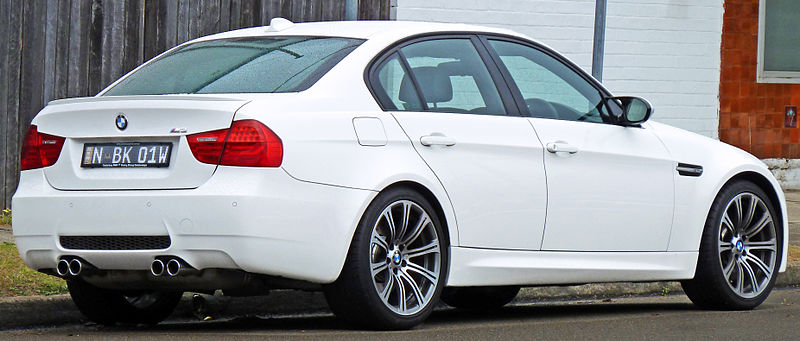After 32 years, the hallow badge that breathes motorsport performance into the 3 Series badge continues to intrigue enthusiasts worldwide. In production since 1985, BMW M3 has been setting the asphalt on fire with its substantially more powerful engine, sturdier suspension, lightweight, and menacing looks that dwarf standard 3 Series models.
With all said and done, lets flip through the history book of the BMW M3 shall we?
E30
 |
| Source: Rudolf Stricker via Wikipedia
Started production in 1985, the first generation M3 was based on the 1986 model year 3 Series. Body style was available only in coupe and convertible styling.
The E30 M3 received its source of propulsion from the venerable S14 engine, a straight 4 DOHC with an M10-based block and M88-based head.
This particular generation spawned two "Evolution" models, christened "EVO2" and "EVO3" respectively. The former was juiced by the S14B23 2.3 litre engine that made 220 PS; the latter, on the other hand, was motivated by a more powerful and larger S14B25 2.5 litre engine that made 238 PS.
The engine was paired to a 5 speed dogleg manual transmission. All of the S14 grunt flowed to the rear wheels. Clutch-type limited-slip differential with 25% lockup was standard across the board, with the US models getting a shorter 4.10:1 final-drive ratio, whereas the European models settled with a taller 3.15:1 final-drive ratio.
Changes from the standard 3 Series encompassed the body and suspension aspect. The former saw a "box flared" wheel arches front and rear to accommodate wider track width and wider tyres along with 12 unique body panels to improve aerodynamic; the latter brought along increased caster angle, solid rubber offset control arm bushings and aluminium control arms.
E36

The second generation M3 debuted in 1992 and was already in dealer's showroom in November 1992. Initially, only coupe body styling was available before convertible and saloon styling appeared in the 1994 iteration.
Engine wise, it was a stark departure from the outgoing E36, becoming the first M3 model to receive the brand's iconic straight 6 engine, coded the S50B30. It displaced 3.0 litre and churned out 282 hp for the European models, with the North American models only making 240 hp. Both the European and North American engines were married to a 5 speed transmission.
It had 86 mm bore and 86 mm stroke respectively, essentially making it a square engine. The engine had 10.8:1 compression ratio and equipped with individual throttle body, Single VANOS, Motronic M3.3 engine management and redesigned intake and exhaust systems.
In September and November 1995, the coupe and saloon model received a much more powerful S50B32 3.2 litre straight 6 (1996-1999 North American models received the less potent S52B32 engine) which saw output figure bumped up to 321 hp. The engine was mated to a 6 speed manual transmission (the North American models still had a 5 speed manual instead), with first generation SMG (sequential manual gearbox) becoming an option in 1997.
The increased displacement was brought about by a longer 91 mm stroke and a slightly larger 86.4 mm bore. Double VANOS and 3 knock sensors were added to the S50B32 engine and compression ratio had been raised to 11.3:1.
The E36 generation featured reinforced subframe, stiffer front spring, aggressive caster and camber due to top hat design and lower control arm bushings.
In 1994, a limited edition M3 GT was produced as a homologation special to fulfill entry requirement into the FIA GT class II, IMSA GT and international long distance races. The E36 M3 GT played host to an upgraded S50B30 engine which saw power bumped up to 291 hp. Only 356 examples were ever built.
E46

In October 2000, Munich rolled out the third generation E46 M3 from the assembly line, featuring a new M-tuned cast iron block S54B32 3.2 litre straight 6 engine. The engine dished out 338 hp for European models, whereas the North American models were slightly detuned to 333 hp. The E46 was only available either as a coupe or convertible.
The S54 carried over the individual throttle body from the S50, but boasting several changes to set it apart from the latter. The changes include 87 mm bore, revised camshafts, 11.5:1 compression ratio, electronic throttle body and scavenging oil pump.
The power of the S54B32 engine was massaged by either a standard 6 speed Getrag manual transmission or the optional second generation 6 speed SMG II Drivelogic.
This particular generation saw the introduction of the M3 CSL (Coupe Sport Lightweight), a limited edition M3 seeing only 1400 examples produced and never offered to the North American market.
The M3 CSL emphasised weight reduction, with large proportions of sound insulation, electric seats and navigation systems removed. Also, air conditioning and stereo weren't available as standard, but can be retrofitted free of charge. Other weight reduction regime included carbon fibre reinforced polymer body pieces, glass reinforced plastics for strengthening certain structural points and thinner rear window. This trimmed the weight down to 1385 kg, 110 kg lighter than regular M3.
Handling had been given a boost thanks to specially developed racing springs and dampers, and tightened steering ratio (14.5 vs 15.4 over the regular M3). The Dynamic Stability Control (DSC) was endowed with "M track mode" that opened the window to push the car to its absolute limits.
Braking power was augmented by larger front rotors and larger rear caliper pistons. The front caliper carrier was also larger than standard M3 giving provision for the larger rotor.
In the engine room, the M3 CSL received an upgraded S54 engine, christened S54B32HP. This fine tuning saw a carbon fibre intake, sharper profile camshafts, a MAP sensor in place of MAF sensor, and lightweight straight path exhaust manifold. This revision saw an increase of 17 hp and 5 Nm over the European M3. Unlike the standard M3, the M3 CSL only came with the 6 speed SMG II transmission with more advanced drivelogic software package that unlocked its ability to shift in staggering 0.08 seconds.
E90/E92/E93

Source: Alexandre Prevot via Wikipedia CC BY-SA 2.0
Onto the E9x generation. The fourth generation M3, launched as a BMW M3 Concept in the 2007 Geneva Motor Show, spawned 3 body styling - E90 saloon, E92 coupe and E93 convertible.
The fourth generation model saw the first M3 to receive V8 engine, coded the S65. A derivative of the S85 V10 found in the E60 M5, the basic architecture and aluminium construction had been carried over to the S65.
The S65 shared identical 92 mm bore and 75.2 mm stroke as on the S85, essentially making it an M5 V10 with 2 cylinders lopped off. Being based on the S85 by extension, the S65 also featured individual throttle body, ionic current knock sensing which detects misfire and knock simultaneously by passing a low voltage across the spark plugs immediately after ignition spark, Double VANOS and 12:1 compression ratio.
Interestingly, the battery only recharged under braking, as the alternator decoupled from the engine under acceleration to reduce power loss. BMW calls it Brake Energy Regeneration.
The lubrication system was taken care of by wet sump system with two electronic scavenging pumps and a main oil pump which replaced the three-pump wet sump system on the S85.
Owing to the aluminium construction, the S65 tips the scale at 202 kg, 15 kg lighter than its cast iron block predecessor, the S54 straight 6 found in the E46 M3.

The standard E90/E92/E93 M3 was motivated by the S65B40 4.0 litre V8 which produced 414 hp and propelled the rear wheels via a standard 6 speed manual transmission. By April 2008, a more advanced 7 speed Getrag M-DCT dual clutch automatic was offered as an option, shortening the 0-62 mph sprint by 0.2 seconds vs. the manual.
The E92 M3 coupe was outfitted with carbon fibre roof, making it 10 kg lighter than the E90 M3 saloon. The E93 M3 convertible was equipped with power retractable hardtop which added 200 kg to the car's overall weight. This certainly took a toll on its performance, as underscored by its slower 0-62 mph acceleration time (4.9 s M-DCT and 5.1 s manual) relative to its E90 and E92 counterpart (4.5 s M-DCT and 4.7 s manual).

Source: The Car Spy via Wikipedia CC BY 2.0
The E9x generation also saw the production of limited edition models such as the E92 M3 GTS and E90 M3 CRT. Both were powered by a larger, 444 hp S65B44 4.4 litre V8 thanks to a much longer stroke of 82 mm and slapped on lightweight titanium exhaust. They were also lighter than the standard M3 thanks to various weight reduction regime.
The E92 M3 GTS was limited to 135 examples, whereas the E90 M3 CRT was available for 67 lucky customers.
F80

Source: Alexandre Prevot via Wikipedia CC BY-SA 2.0
Finally in 2014, the fifth generation F80 M3 made its premiere at the 2014 North American International Auto Show in Detroit. The F80 M3 is currently available only in a saloon body style, as per BMW's plan to split off the coupe/convertible 4 Series from the 3 Series.
The F80 heralds a new generation M3 that breathes on turbochargers and also a return to straight 6 engine, resulting in the 425 hp S55B30T0 3.0 litre twin turbo straight 6. The new engine powers both the F80 M3 and its F82/F83 M4 coupe and convertible sibling.
The S55 features a closed-deck block, lightweight crankshaft, stronger pistons, different valve material, twin fuel pumps and revised intercoolers.
Transmission option is between the 7 speed M-DCT dual clutch automatic and 6 speed manual. The former accelerates the F80 M3 from 0-62 mph in just 4.1 seconds, whereas the latter is 0.2 seconds slower, recorded at 4.3 seconds.
The F80 M3 is adorned with carbon fibre roof just like the outgoing E92 M3 coupe. The bonnet and doors however are made of aluminium. Steel forms the backbone of its platform structure.
In February 2016, the M3/M4 Competition Package has been included in Munich's product catalog. The package entails an increase in power, up from 425 hp to 444 hp. It also brings improvement on handling front, with new springs, dampers and anti roll bars complementing the Adaptive M Suspension, along with retuned electronic differential and Dynamic Stability Control (DSC).
Equipped with Competition Package, the F80 saloon completed the 0- 62 mph sprint in 4.0 seconds, an identical time with its F82 M4 coupe counterpart, whereas the F83 M4 convertible took 4.2 seconds to achieve the same feat. All acceleration times were timed with the M-DCT variant.
The Competition Package graces the interior with lightweight sport seats and M-striped seat belts. On the exterior front, it tacks on M Sport exhaust with black chrome tailpipes and high gloss Shadow Line exterior trim.
|
